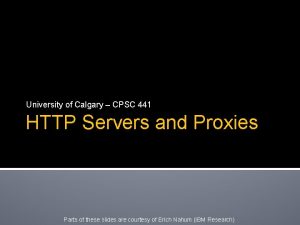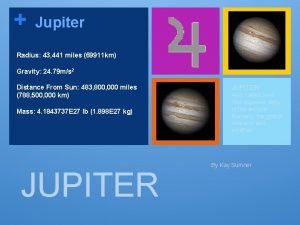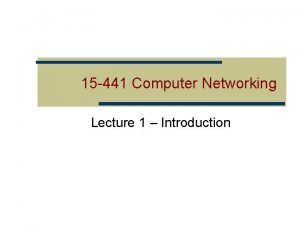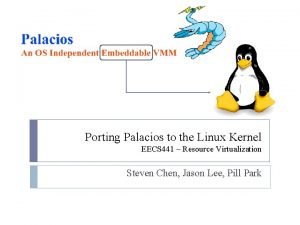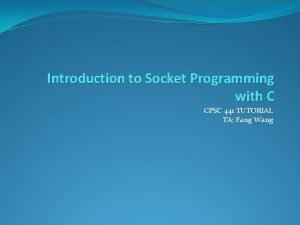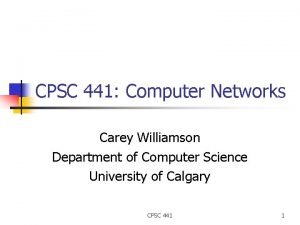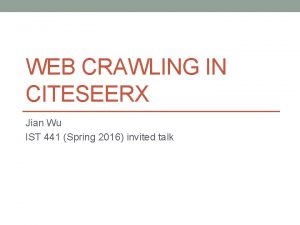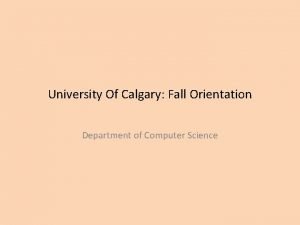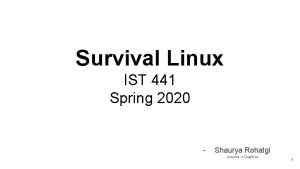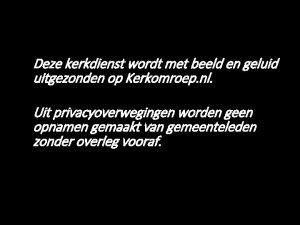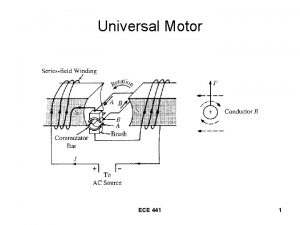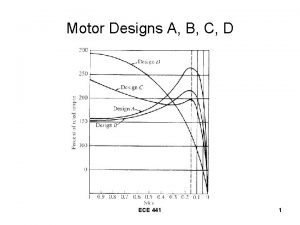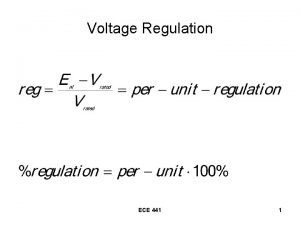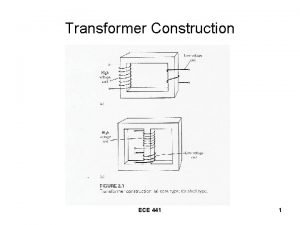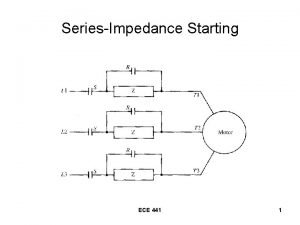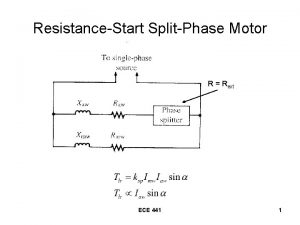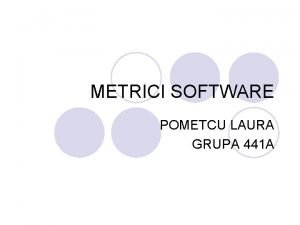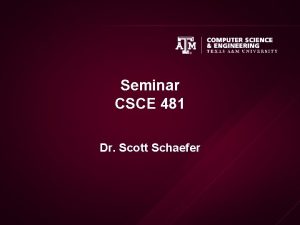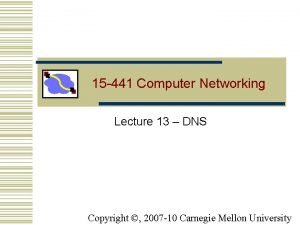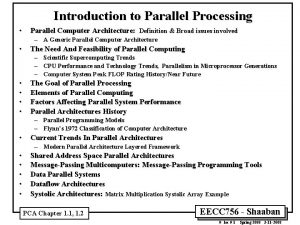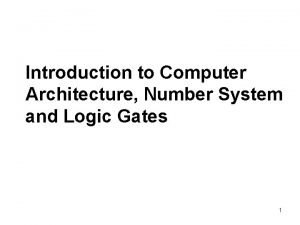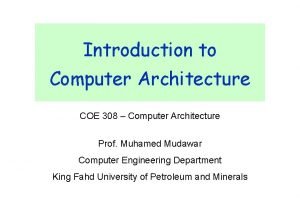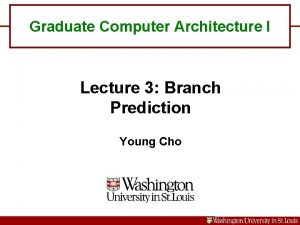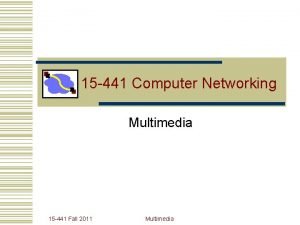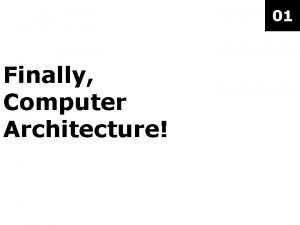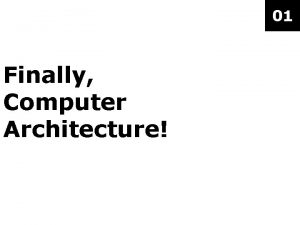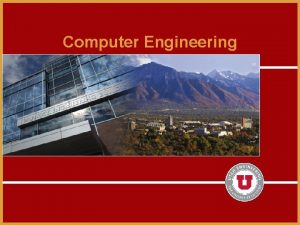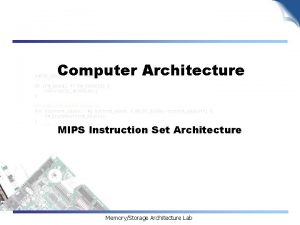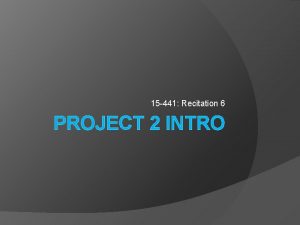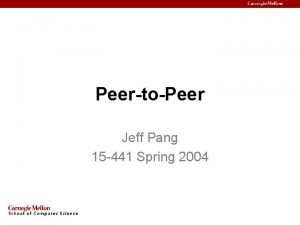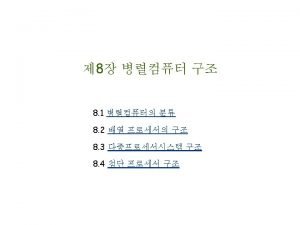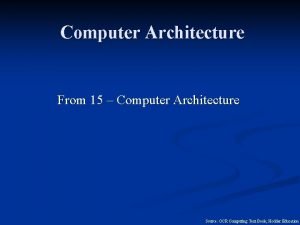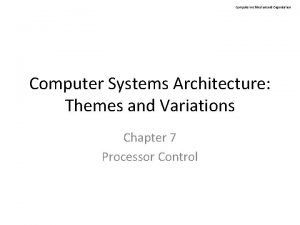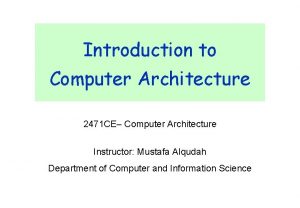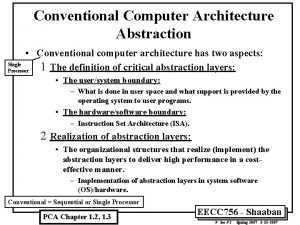Intro to Computer Architecture CR 346ECE 441 Prof























































- Slides: 55

Intro to Computer Architecture CR 346/ECE 441 Prof. Lyon

How We Interact with Computers User Applications Operating System Hardware

Remember, everything is represented in bits! 2 Bits – 00, 01, 10, 11 = 3 Bits – 4 Bits. . 8 Bits 16 Bits 24 Bits- 4 values 8 values 16 values 256 Values 65, 536 Values or (+/- 32, 767) 16, 777, 216 Values

What are computers made of? Primarily Transistors Invented in 1951, the Transistor is the basic electrical building block for all modern electronics Called by many the greatest invention of the 20 th century For Digital applications, transistors are packaged in what is known as Integrated Circuits (ICs) As many as 1 Billion Transistors can be packaged in a single large IC today

Anatomy of a Transistors are fabricated using silicon (derived from quartz) and tiny amounts of impurities such as selenium or gallium arsenide to create what is called a “semiconductor” Semiconductors allow us to control the flow of electrical charge (electrons) very precisely. Millions of semiconductors can be placed on an integrated circuit using a process called photolithography

CD CD=critical dimension, target design rule Proportional to the wavelength of illumination

Transistor Functionality In various circuits Transistors can be made to: Amplify or Attenuate electrical signals Invert electrical signals Store electrical voltage values Switch electrical signals off and on Transistors can be combined to create logic circuits commonly known as “GATES” Gates are packed into Integrated Circuits commonly known as “Chips”

Simple Silicon Semiconductor Devices

Intel 4004 Processor Chip circa 1971 It could only add and subtract 4 bits at a time.

AMD Athlon 64 Processor 2004

Use of Logic Gates in Computers Primary Uses: Switches and logic circuits that can be switched between 0 and 5 volts. In this way a Switch can signify a “bit” that is a 1 or a 0 Storage of voltage levels equivalent to 0 or 5 volts. In this way a “bits” of memory can be implemented or pixels on an LCD display on a laptop can be created

AND and OR Gates

NOT Gate

By combining gates we can create useful functions such as a the ability to store a bit of information The purpose of a latch is to allow a data value to be stored temporarily. So that we can hold it and “use” it for awhile…like a “bit” of memory

John Von Neumann (1903– 1954) Von Neumann visits the Moore School in 1944 prepares a draft for an automatic programmable device (later called EDVAC) “stored program” concept publishes ideas (with Goldstine and Burks) in 1946 designed the IAS (Institute for Advanced Studies) machine which became operational in 1951

Von Neumann Architecture “stored program” serial uniprocessor design binary internal encoding CPU–Memory–I/O orgranization “fetch-decodeexecute” instruction cycle

The Von Neumann Machine CPU = Central Processing Unit Memory

A Typical PC CPU Board

Fetch, Decode, Execute Cycle • Computer instructions are stored (as bits) in memory. To run a program, each instruction is: • Fetched from memory. • Decoded (the computer figures out what it should do based on the number). • Then the instruction is executed. • The speed at which this cycle occurs is determined by the system clock

Cycle Times • Generally the faster your computer can get through a fetch-decode-execute cycle, the faster it will perform. • Cycle times are measured in “gigahertz”, a billion cycles per second. • PCs these days reach 3500 Megahertz or 3. 5 Gigahertz (3 billion cycles/sec)

Memory • Each memory unit has its own address • Memory units are organized in groups of Bytes (8 bits) or Words (16, 24, 32, 64 or 128 bits) 0 1 2 3 4 …………………. . 127 million

Random Access Memory • The main computer memory is called RAM (Random Access Memory) • It is “random” in that one may access any addressable memory unit independently of any other (and thus in “random” order). • In almost all modern machines the smallest single addressable amount of memory is one byte. • Memory is measured in megabytes or gigabytes or terabytes

RAM chips on a PC board

DRAM • RAM allows for both reading and writing in memory. Contrast this with ROM (readonly memory). • Most RAM is volatile, or “dynamic”. When you turn off the power, the contents of RAM is lost. • Sometimes one talks about DRAM which is short for dynamic RAM).

ROM Read Only Memory can only be read from It’s contents cannot be altered or written over easily This type of memory is used to hold instructions that need to always be there and always be the same For example, the initial instructions that are executed when your PC is turned on which instructs the machine to load Windows from the disk drive

Registers are memory locations that are used to facilitate the movement of data inside a digital computer Registers work in conjunction with the system clock which determines the speed with which a computer fetches and executes instructions

Basic Registers in a computer IR – Instruction register ACC – Accumulator, used as a scratchpad MDR – Memory Data register MAR - Memory Address register PC – Program Counter, points to the next instruction to be fetched

More about the CPU Two of many “registers” in the CPU Instruction Register (IR) Accumulator Memory

Machine Language • Every von Neumann style CPU has its machine language, the set of instructions it knows how to execute. • CIA=Complement and Increment the accumulator (PDP-8) • 7404=NOP (PDP-8)

Machine Instructions • Such an instruction would consist of two numbers: • One would be the address of the memory unit to be accessed. • The other would be the operation code of the instruction - the (somewhat arbitrary) number that refers to a unique and particular type of instruction

Structure of Instructions Suppose we used 32 bits to encode a machine language instruction. 7 bits Op code 7 bits would allow us to have 128 different op codes. 25 bits Memory address 25 bits would allow about 32 megabytes of addressable memory. We might need to fetch more bytes if we had to address a larger range of memory

Information Transfer inside the CPU • Individual bits in a memory unit are transferred to the CPU in parallel (all at the same time). • This is opposed to serially (one at at time). • The same goes for information transferred between registers in the CPU. • A 64 bit machine can transfer 64 bits in parallel.

The Memory Bottleneck • In almost all of today’s machines, the machine can perform dozens of instructions in the time it takes to retrieve one item from memory. • One solution is very fast memory in the CPU call cache memory. A computer will typically have 1000 s of bytes of cache, as opposed to billions of bytes of RAM.

Cache Memory CPU Cache memory is on the CPU chip. Instruction Register (IR) Accumulator Cache Memory

Central Processing Unit manages the instruction-execution cycle FETCH – DECODE – EXECUTE coordinates the activities of other devices

The CPU and Main Memory

Inside the CPU

Inside the CPU memory address register

Inside the CPU memory address register memory data register

Inside the CPU memory address register program counter memory data register

Inside the CPU memory address register instruction register program counter memory data register

Inside the CPU memory address register memory data register instruction register program counter arithmetic logic unit

Inside the CPU memory address register instruction register program counter memory data register accumulator (work register) arithmetic logic unit

Inside the CPU memory data register memory address register accumulator (work register) instruction register program counter system clock arithmetic logic unit

FETCH the instruction 1. address of the next instruction is transferred from PC to MAR 2. the instruction is located in memory

FETCH the instruction 3. instruction is copied from memory to MDR

DECODE the instruction is transferred to and decoded in the IR

EXECUTE the instruction control unit sends signals to appropriate devices to cause execution of the instruction

Types of Processor Operations Data Movement Operations – moving data from memory to the CPU – moving data from memory to memory – input and output Arithmetic and Logical Operations – integer arithmetic – comparing two quantities – shifting, rotating bits in a quantity – testing, comparing, and converting bits

Types of Processor Operations Program Control – starting a program – halting a program – skipping to other instructions – testing data to decide whether to skip over some instructions

Smaller, Cheaper, Faster! The Mantra of the Semiconductor Industry

Moore’s law

Clock Frequency Lead microprocessors frequency doubles every 2 years 10000 2 X every 2 years Frequency (Mhz) 1000 P 6 100 486 10 8085 1 0. 1 1970 8086 286 Pentium ® proc 386 8080 8008 4004 1980 1990 Year Courtesy, Intel 2000 2010

Challenges to Continuing the Trend The thickness (in atoms) between the silicon layers in transistors is getting very thin as we attempt to cram more transistors into the same amount of space…so much so that new materials need to be developed HEAT!! As we put more and more transistors on a chip, the ability to cool it and keep it from burning up is increasingly a problem Noise - As more transistors are packed ever more tightly together, the noise level of the circuits increases which affects reliability

A New Computing Paradigm? Quantum Computing Seeks to use the “spin” of atomic particles to implement binary digital systems Molecular computing Using molecules to hold electrical charges instead of using transistors Very much in preliminary research…. not here yet
 Bus architecture in computer organization
Bus architecture in computer organization Diff between computer architecture and organization
Diff between computer architecture and organization Basic computer organization
Basic computer organization Cpsc 441 u of c
Cpsc 441 u of c Jupiterradius
Jupiterradius Dchr paid family leave
Dchr paid family leave Cmu 15-441
Cmu 15-441 Eecs 441
Eecs 441 Cpsc 441 assignment 1
Cpsc 441 assignment 1 Cpsc 441
Cpsc 441 Broad phase vs narrow phase
Broad phase vs narrow phase Ist 441
Ist 441 University of calgary orientation
University of calgary orientation Linux
Linux Lied 433
Lied 433 Ece
Ece Ece
Ece Voltage regulation
Voltage regulation Ece 441
Ece 441 Ece 441
Ece 441 Ece
Ece Calculati 441-(-15)2
Calculati 441-(-15)2 Ece 441
Ece 441 Scott schaefer tamu
Scott schaefer tamu Cpsc 441
Cpsc 441 Cmu 15-441
Cmu 15-441 Explain architecture business cycle
Explain architecture business cycle Call and return architecture
Call and return architecture Modular vs integral product architecture example
Modular vs integral product architecture example Integral vs modular architecture
Integral vs modular architecture Computer organization and architecture 10th solution
Computer organization and architecture 10th solution Computer architecture 101
Computer architecture 101 Computer architecture lab experiments
Computer architecture lab experiments Introduction to computer organization and architecture
Introduction to computer organization and architecture Timing and control in computer architecture
Timing and control in computer architecture Evolution of computer architecture
Evolution of computer architecture Dma controller in computer architecture
Dma controller in computer architecture Fp adder
Fp adder Addressing mode in computer architecture
Addressing mode in computer architecture Static interconnection network in computer architecture
Static interconnection network in computer architecture Smt computer architecture
Smt computer architecture Bclt mips
Bclt mips Collision vector in pipelining
Collision vector in pipelining Instruction format in computer architecture
Instruction format in computer architecture Concept of nano programming
Concept of nano programming Microprogram sequencer block diagram
Microprogram sequencer block diagram Memory system
Memory system Virtual memory tlb
Virtual memory tlb Difference between linear and nonlinear control system ppt
Difference between linear and nonlinear control system ppt Computer architecture definition
Computer architecture definition Parallel processing architecture
Parallel processing architecture Architect of the concept of number system
Architect of the concept of number system Computer architecture definition
Computer architecture definition Instruction set architecture
Instruction set architecture Write any three input devices
Write any three input devices Branch prediction
Branch prediction



